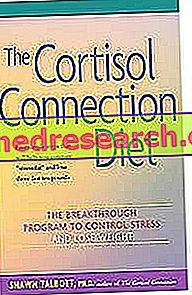The Cortisol Connection Diet is a diet proposed in the States, in the first half of the 2000s, by Shawn Talbott PHD, author of the book " The Cortisol Connection Diet ".
It is a diet useful for controlling the secretion of cortisol in the body; as we know, cortisol is a hormone that, if produced in excess, manifests with some "evidence" some SIDE effects on weight control, such as the reduction of lipolysis and the increase in muscle catabolism .

It happens frequently that, during the weight loss process, at some point the weight stops falling; often, this stalemate condition follows a period of great slimming effectiveness (reduction in body weight greater than 3.5-4 kg monthly). Some professionals interpret this arrest in weight loss as a side effect of cortisol hyper-secretion, a bio-regulator that (in many subjects, but NOT in all) is produced almost in proportion to general stress (both psychic and physical).
From my point of view it is unmistakable that a hypothetical hormonal imbalance can weigh heavily on the metabolic and energetic balance, however it would be appropriate to start talking about blood concentrations THRESHOLD . It is therefore not necessary to further confirm the stress-cortisol ratio, because in the literature it is already possible to find several inherent works; rather, it is ESSENTIAL to understand and demonstrate what are the PARA-physiological hormonal fluctuations that could negatively affect the body. In simple terms...
No one cares if more cortisol is produced due to stress ... what we are EVERYBODY curious to know is WHICH is the level of counterproductive hypersecretion to a slimming diet!
In my opinion, without such data, bringing up hormonal alterations MAY seem a good excuse to justify the failure of a clumsy specialist and / or a demotivated patient. Furthermore, let us remember that for a series of concomitant factors, the closer we come to our "balance point" (probably placed near the desirable physiological weight), the less the body will be willing to reduce its body weight.
A similar condition often leads professionals and laymen to insist on therapy, further limiting the energy supply of food. This is a wrong attitude, because in my opinion (confirming what has been claimed by many other specialists) excessively prolonging a slimming (hypocaloric) diet, regardless of how challenging it may be, it often proves a bankruptcy and counterproductive strategy .
Apart from Cortisol, in order to establish the treatment time limit, it is essential to take into consideration some factors:
- Therapeutic compliance, ie the patient's difficulty in following and respecting the dietary pattern. According to the Cortisol Connection Diet, the demotivation and suffering of the person in following a restrictive or inadequate diet would favor the alteration of cortisol itself ... I have serious doubts about it, even if it seems unequivocal however the correlation between diet NOT personalized and failure of the therapy itself. What for a supporter of the Cortisol Connection Diet might seem like a surge of cortisol ... I justify it with the patient's omission (often out of shame) in declaring the tendency to repeated sgarri evening. These are often justifiable by the excessive nutritional restriction of the diet.
- Nutritional balance: it is not advisable (and not professional) to administer deficient, unbalanced dietary plans or those requiring multiple integration for long periods; in any case, any hypocaloric (even the only 10% reduction in useful calories) should NOT be followed for more than 8 months. Moreover, many still live (who knows for how long ...) in the age of abundance, what is the point of spending so much money to eat less and buy tablets?
- Changes in body mass: seeing the needle of the balance go down is certainly a desirable result, especially for a person who is overweight or obese; nevertheless, it is quite important that this corresponds to a REAL decrease in subcutaneous fat with conservation of muscle mass. Getting out of weight but losing muscle is absolutely wrong! It is known that in conditions of nutritional depletion the weakening of anabolism and super muscular compensation is inevitable; however, a realistic goal could be to preserve the most intact muscle mass possible. Also in this case, the Cortisol Connection Diet would attribute the catabolism of lean tissue to the excess of circulating cortisol; in reality, what often happens is that the patient exaggerates with physical activity at the same time as caloric restriction or that the dietary regimen is typically IPOglucidic and concomitant with an aerobic sport, therefore strongly oxidative.
This Cortisol Connection Diet tries (to my mind in vain) to ignore the concept of calorie restriction; rather, nutritional balance is emphasized by respecting the " Balance Index " parameter . This involves a bifocal management of the food: on the one hand the quantity (considered NOT little, but fair!) And on the other the quality.
With regards to quantity, I must admit that some small tricks are proposed that are very useful for the calculation of food portions, while as far as quality is concerned it is sufficient to follow the rule of compensation; that is: the foods can be of good quality (foods with low glycemic index, containing fibers, proteins with high biological value, unsaturated and polyunsaturated lipids) or of low quality (refined foods with high glycemic index, with few fibers, incomplete proteins, lipids saturated or hydrogenated). For each of the 6-7 RECOMMENDED daily meals it is essential to manage the food keeping the Balance Index high, compensating for low quality foods with good quality ones: for example white bread (low q.) + Grilled chicken breast (high q .).
Ultimately, the Cortisol Connection Diet tries to limit cortisol hypersecretion by fragmenting daily meals, with particular attention to the morning period, which is more sensitive to the oscillation of this hormone. It also aims at the correct choice of food associations and the identification of an effective but not drastic weight loss range (1200-1800kcal).
Personally, I consider it admirable the choice to supply almost all the nutrients in a balanced way at every meal, and I think it is useful to provide a valid tool to calculate the most suitable portions; on the other hand, don't tell me that the Cortisol Connection Diet is NOT hypocaloric! It is all right! The calculation of the portions, the distribution and the management of meals clearly reflect the dietary patterns and the traditional guidelines, with the difference that a classic method builds a GRAMMATE program, while the Cortisol Connection Diet is much more practical and elastic in the portions, and for this reason also approximate.
In conclusion, I find the Cortisol Connection Diet a useful strategy for controlled weight loss but once again there are no such innovative concepts as to be able to justify the preference with respect to the traditional method.



